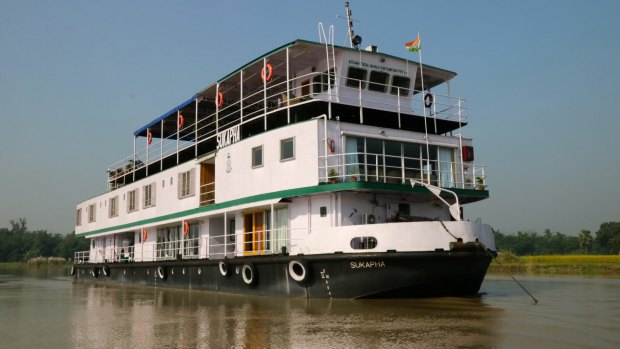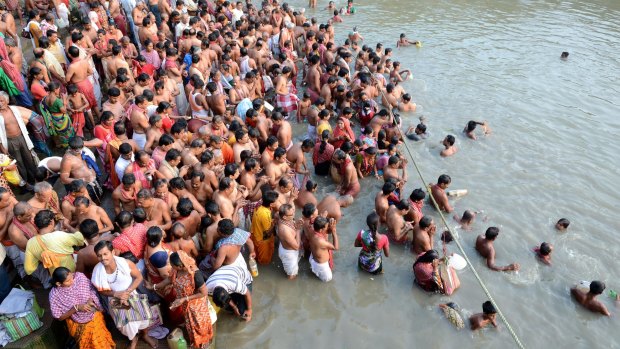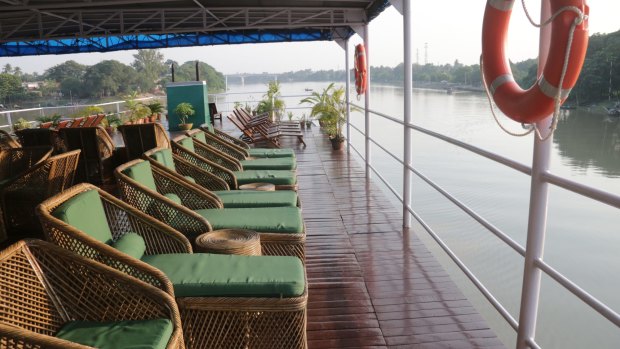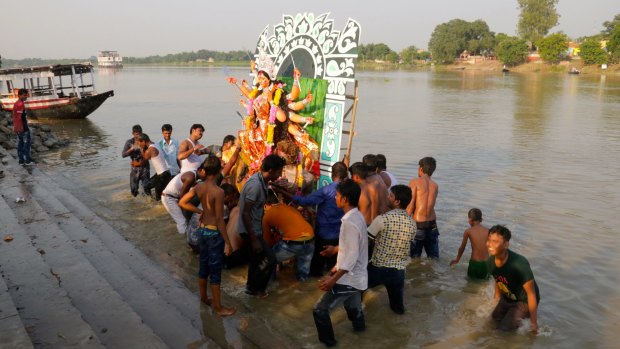This was published 7 years ago
Indian river cruises: Down the Ganges with G Adventures

MV Varuna on the River Ganges.Credit: Louise Southerden
It's the middle of a steamy, east Indian day and I'm reading Rudyard Kipling, a cloth-bound book of his short stories I'd found in the ship's library that morning, while sipping Darjeeling tea from a white china cup on the deck of a riverboat cruising slowly down the Ganges.
A warm, smoke-scented breeze ruffles the pages. Suddenly, shouts from the riverbank rouse me from The Man Who Would Be King and I'm back in the 21st century, waving at barefoot boys running alongside as we chug past.
It's one of the paradoxes, and delights, of this nine-day trip, G Adventures' inaugural Ganges River cruise, that in a country of 1.2 billion people, less than a day's drive from Kolkata, a city of 14 million of them, you can slip in and out of time and off the tourist map to the point where you could be the first Europeans to visit this south-eastern corner of West Bengal. How is that possible?

Hindu ritual in the Ganges.Credit: Alamy
NIGHT TRAIN TO THE RIVER
The trip had started with a four-hour train ride to Farakka, 300 kilometres north of Kolkata. Or rather a five-hour wait for it. By the time we finally depart, hopes of a preview of the country we'll be cruising through have been dashed by darkness.
My companions and I pass the time by eating – a surprisingly good four-course dinner of samosas and soup and curries and ice cream served in "A/C Chair Class" – until we stumble off the train around midnight and on to our waiting ship, the 40-metre MV Varuna, moored quietly at a dock just out of town.

Cane chairs on the top deck.Credit: Louise Southerden
This being India, we're met by uniformed crew bearing chilled towels and cool drinks and a light dinner has been prepared, despite the late hour. But I say goodnight, tired from the long day and eager to explore my home-away-from-home for the next week and a half.
Like the rest of the three-deck ship, my twin cabin is lovelier than I'd expected: all white bed linen and bamboo-panelled walls and printed cushions that match the curtains. There's air-conditioning, large sliding windows, cane chairs and a large bathroom stocked with Ayurvedic toiletries.
Best of all it's one of only 12, making only 24 passengers on board, a number I appreciate the next morning when we set off on our first shore excursion. (We haven't cruised anywhere overnight, but there's much to see before we set off downstream.)

An effigy of Hindu goddess Durga is thrown into the Ganges at the end of a festival.Credit: Louise Southerden
After a sumptuous buffet breakfast, we pile into waiting SUVs that take us along busy roads, our drivers artfully dodging trucks, motorbikes and tuk-tuks to take us to mosques and monuments, forts and temples, each a puzzle piece in West Bengal's complicated story of dynasties lost and kingdoms won until European traders arrived in the 16th century.
HOOGHLY OR GANGES?
But first we get our bearings – by crossing the Farakka Barrage, a concrete weir built in 1974 to divert water from the Ganges (which flows east from here into Bangladesh, where it's called the Padma) into the Hooghly, the Portuguese name for the river that flows south to Kolkata. (The diversion prevents Kolkata's port from silting up.)
As we drive from one end of the two-kilometre-wide barrage to the other – the road so potholed a Barbie-sized Hanuman god swings wildly from the rear vision mirror in my vehicle – Abhi Chhetri, our G Adventures expedition leader and "CEO" (chief experience officer), points to the latte-coloured water on our right.
"That is the Ganges," he says, before pointing to the left, below the barrage, where our ship lies. "And that is the Hooghly. But it's the same water."
So we're actually on a Hooghly River cruise? Technically, but not exactly. Until the 12th century the river now called the Hooghly was the main arm of the Ganges. As our guide Debabrata Mukherjee puts it: "It was never the Hooghly, it is still not the Hooghly, to the people of Bengal; it is Ganga."
Back on the Varuna that afternoon, we set off at last down the river that, whatever we call it, flows more than 2500 kilometres from the world's highest mountain range to its largest delta, sustaining a 10th of the world's population in between. No wonder it's sacred.
That evening, we gather on the top deck for pre-dinner drinks, a casual affair; no one dresses up, some of us go barefoot. The smell of cow dung mingles with wood-smoke, we watch farmers riding bicycles along the rims of rice fields and the muddy water shimmers, bathed in haze and golden light. Then the light fades and everything becomes still, even the engines (we're at anchor every night, river navigation being too dangerous in the dark). Under us, the river flows on.
AN UNTOURIST IN INDIA
By the next afternoon, we're in Murshidabad to see three palaces built for "nawabs", Muslim rulers appointed by Mughal emperors of the day. One mustard-yellow palace wouldn't look out of place in rural France. Another has British Raj written all over it, with its columns and colonnades and stone-lion gates.
The most impressive is Hazarduwari, "the palace of 1000 doors", built as a 144-room guesthouse for visiting British dignitaries in the 1830s. Today it's a museum filled with an embarrassment of riches, from ivory palanquins and feathered punkahs to solid-gold thrones and crystal chandeliers.
It's the only place we see other tourists all week. Not Westerners like us; Hazarduwari's high-ceiling corridors are awash with the sari swirls, sparkling bindis and shiny black hair of holidaying Bengalis in their Sunday best.
That night, our captain manouevres the ship to an anchorage mid-river. It's only when we're up on deck for a tandoori barbecue dinner that we realise why. Before us is a surreal sight: the floodlit facade of Hazarduwari, looking uncannily like Berlin's Brandenburg Gate.
RIVER LIFE
"This method of travelling is slow, desperately slow, but it is convenient; for while the boat is gliding gently through the water, the occupant may be employed in drawing, writing, music or any other pursuit of the kind without the annoyance of rolling, tossing or shaking."
The words of Lieutenant Thomas Bacon of the British East India Company seem as apt today as they were in 1837. And although we see only two or three other riverboats all week, live-aboard cruising is surely one of the best, and easiest, ways to experience India.
From day three onwards, we have a few languid hours between morning and afternoon shore excursions each day to relax on deck watching river life unfold from our cane chairs, drinking chai.
Boats cross the river loaded with bicycles and people standing under black umbrellas. Women squat at the water's edge washing silver pots that glint in the sun, while their laundry, long rectangles of wet saris, brightens the riverbanks. Youths bathe buffaloes, buffaloes plough fields. Occasionally we see a funeral pyre or a headless straw effigy of the Hindu goddess Durga (thrown into the river at a village upstream).
Serene, we glide past in our post-colonial bubble. A river dolphin breaks the surface, and is gone.
But we do burst out of the bubble, to make contact with the people and places we cruise past. "People think India is monuments," says Abhi when we go ashore after lunch on day four, "but it's the people and communities that make it."
That afternoon we visit the forested site of the Battle of Plassey, a turning point in the fortunes of east India. In the pouring monsoonal rain of June 1757, the British East India Company defeated the Nawab of Bengal and took control of the region, kicking off almost 200 years of British rule – first by the East India Company (until 1858) then by the British Crown, which ruled until independence in 1947.
Then we walk along a dusty road behind the battlefield to a nearby village and step into timeless India again where we see thatched, mud-walled houses and meet men wheeling carts of jute, women pressing cow dung on to sticks to use as cooking fuel, babies with kohl-rimmed eyes and boys doing Blue Steel poses for our cameras.
THE STORY OF INDIA
As we travel south, self-sufficient villages like this grow into towns of industry (such as Matiari, a brass-making town we visit on day five), horse-drawn carts are replaced by electric tuk-tuks, buffalo give way to tractors, the boats get bigger, bridges span the river, the skyline is spiked by power station smokestacks. It's the story of India, told by a river.
Then, on the afternoon of day five, an anomaly. A vast domed building under construction looms on one side of the river like an alien spacecraft. It's a new temple at the world headquarters of the Hare Krishna movement, aka International Society for Krishna Consciousness or ISKCON, in Mayapur.
We go ashore in our "country boat" (a small covered boat that takes us from ship to shore) to spend a couple of hours at this massive complex with its souvenir stalls and armed guards, three-storey apartment blocks (for visiting devotees) and billboards requesting donations, the seriousness of it all interrupted by murals depicting Krishna as a chubby blue baby.
A LITTLE BIT OF FRANCE
One of the best things about this trip is that our guides are opportunistic, taking advantage of gaps in our schedule. On our second last night, for instance, we have an unscheduled after-dinner stroll along a riverside esplanade in Chandannagar, a former French colonial town, mingling with couples and families, fishermen and "fuchka" sellers (it's a pappadum-like street food), sidestepping sacred cows that remind us where we are.
The next morning, we return to the town that was, in the 18th and 19th century, a little bit of France far from home. Gallic influences linger: we visit a school run by French nuns, a French cemetery, a former French governors' house that's now a museum filled with French antiques and a Catholic church, the Sacred Heart, a surprise highlight of the whole trip.
"My name happens to be Orson Wells (sic)," says the parish priest, who shows us around. "My father liked the movie A Man for All Seasons," he explains, before telling us he grew up Catholic in Kolkata and Mother Teresa was his Sunday school teacher. Then he gives us an impromptu tour that ends in the church's basement, where we find a rickshaw hearse. "How can you say it's a hearse?" he laughs. "It's a bicycle built for two! I can give you a tour of the city – lying down!"
This is the trip to do when you start to feel jaded about travel, when you begin to believe that the world's places, people and experiences have all been seen by tourist eyes and neatly bundled into holiday packages. Sure, it's a commercial river cruise, with an itinerary and guides and three meals a day, but it's also as free-flowing as the Ganges, a reminder that there's a universe of experiences beyond Planet Western Civilisation out there, just beyond the railing.
TRIP NOTES
MORE INFORMATION
GETTING THERE
Singapore Airlines and Silk Air fly to Kolkata daily via Singapore from Sydney, Melbourne, Brisbane, Adelaide and Perth. See singaporeair.com
Australians require a visa for India; an e-Tourist Visa can be obtained for $60 up to four days before departure. See indiavisaonline.gov.in
CRUISING THERE
G Adventures' nine-day Ganges River Experience runs January-May and July-September. Trips begin in Kolkata with a train ride upstream to Farakka where you'll board the MV Varuna. Cabin rates start at $1609 per person. There's also an eight-day Ganges River Adventure (Patna to Farakka) and 12-day Cruise the Ganges trip (Kolkata to Varanasi). See gadventures.com.au
Louise Southerden travelled as a guest of G Adventures.
Five more bits of the Ganges to see in West Bengal
1.Darjeeling: Tea and more. At the foothills of the Himalayas, near the source of the Ganges, this former British Raj region has tea lounges, plantation tours, whitewater rafting and the legendary Windamere Hotel. See darjeeling-tourism.com
2. Durga Puja: Festival of the year. Bengal loves festivals and the biggest is this week-long public holiday in September/October celebrating the many-armed Hindu goddess Durga, which ends with effigies being thrown into the Ganges.
3. Kolkata: City of Joy. The capital of West Bengal is one of the friendliest, most cultured cities in India. Ride its famous yellow Ambassador taxis across the Ganges at Howrah Bridge and between landmarks such as Victoria Memorial and Mother (Teresa) House.
4. Sundarbans: Tiger islands. This mangrove-forested World Heritage Area at the delta of the Ganges sprawls over the India-Bangladesh border and is THE place for a Bengal tiger safari. See royalsundarban.com
5. Sagar Island: River's end. The largest island in the Ganges delta, 100 kilometres downstream from Kolkata, Sagar is where Mother Ganga flows into the Bay of Bengal and Hindu pilgrims come to pray and take a dip at one of the black-sand beaches.
Sign up for the Traveller Deals newsletter
Get exclusive travel deals delivered straight to your inbox. Sign up now.